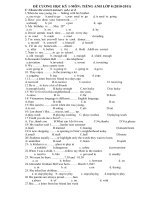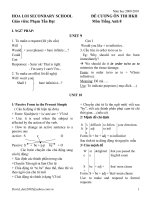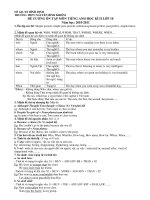ĐỀ CƯƠNG HÓA HỌC ĐẤT TIẾNG ANH
Bạn đang xem bản rút gọn của tài liệu. Xem và tải ngay bản đầy đủ của tài liệu tại đây (2 MB, 25 trang )
HÓA HỌC ĐẤT
Question 1
a. Present a nitrogen cycle within the earth system.
b. Present organic matter classification in soils.
c. Write a cellulose molecular structure with four sugar monosaccharides
a. Trình bày một chu kỳ nitơ trong hệ thống trái đất .
b . Phân loại chất hữu cơ có trong đất .
c . Viết một cấu trúc phân tử cellulose với bốn monosacarit đường
a.
From the diagram of global nitrogen cycle, we can summarize key processes:
Stock of soil nitrogen depends on N fixation processes and decay processes of
organic N compounds.
Major fixation processes consist of biological fixation and Haber -Bosh process.
Decay processes include immonification (mineralization), nitrification,
denitrification.
The slides below will present major processes of N cycle in soils
1
1
+ Haber-Bosch/industrial N fixation
The Haber Process combines nitrogen from the air with hydrogen derived mainly
from natural gas (methane) into ammonia.
N2+ 3H2 2NH3(ΔH = −92.4 kJ·mol−1)
+ Ammonification /mineralization
Nitrogen enters the soil through the decomposition of protein in dead organic matter
Amino acids + 11/2O2 CO2+ H2O + NH3+ 736kJ
This process liberates a lot of energy which can be used by the saprotrophic microbes
+ Nitrification
Two step reactions that occur together :
2
2
1rststep catalyzed by Nitrosomonas
2 NH4++ 3 O2 2 NO2-+2 H2O+ 4 H+
2ndstep catalyzed by Nitrobacter
2 NO2-+ O2 2 NO3+ Denitrification
Denitrification is a natural soil microbial process where nitrate (NO3 - ) is converted
to nitrogen (N) gases that are lost to the atmosphere.
b. b. Present organic matter classification in soils
3
3
c. Write a cellulose molecular structure with four sugar monosaccharides
• Polysaccharides, the polymers of sugars, have storage and structural roles
• The structure and function of a polysaccharide are determined by its
sugarmonomers and the positions of glycosidic linkages
Question 2
4
4
a. Present soil colloid classification.
b. Present concepts of adsorption, absorption, desorption, adsorbate, adsorbent
a. Hiện phân loại keo đất .
b . Khái niệm hiện tại của hấp phụ , hấp thụ , hấp phụ , adsorbate , vật liệu hấp phụ
a,
Soil colloids can be classified by crystal structure
+
5
Crystalline Silicate Clays
• Dominant colloid in most soils (not andisols, oxisols or organic soils)
• Crystals layered as in a book
• 2-4 sheets of tightly-bonded O, Si and Al atomsin each layer
Kaolinite
• Kaolinite is one of the most widespread clay mineral in soils, being most
abundant in warm moist soils.
• It is formed by acid weathering and in soils of volcanic origin.
• Hydroxyl plane is exposed: removal or addition of hydrogen ions cproduce
positive or negative charges (hydroxylated surface also binds with anions)
• Hydroxyls of octahedral sheet are alongside oxygens of the tetrahedral sheet:
hydrogen bonding results, with no swelling in kaolinit
Smectite group:
• Smectite includes montmorillonite, beidellite, nontronite. It occurs widely in
moderately weathered soils. Montmorilloniteis most common smectite in soils.
• Interlayer expansion may occur as H2O fills spaces between layers in dry
clay
• Smectites have a large amount of negative charge due to isomorphous
substitution
• Mg2+often replaces Al3+in the octahedral sheet
• Al3+sometimes replaces Si4+in the tetrahedral sheet
• Weak O: cation linkages between layers leads to plasticity, stickiness,
swelling and a very high specific surface area
Vermiculite group
5
• It is formed as a alteration product of muscovite and biotite mica. It has a
wide particle size range.
• Very high negative charge due to frequent substitution of of Si4+ions with
Al3+in the tetrahedral sheets.
•Cation exchange capacity is higher in vermiculitesthan in any other clay.
• Swelling occurs, but less than in smectites due to strongly adsorbed H2O
molecules, Al-hydroxy ions and cations, which act more as bridges than
wedges.
+ Non-crystal colloids
• Not organized into crystalline sheets
• Both + and – charges; can adsorb anionssuch as phosphate
• High water-holding capacity
• Malleable (change in shape) when wet, but not sticky
• Often form in volcanic soils (especially in Andisols)
+ Fe, Al oxides
• Oxides include hydroxides, oxyhydroxides occurs as
discrete particles, coatings on other soil surfaces.
• Hydroxylation of oxide minerals can be structural or
occurs by chemisorption of water in an aqueous medium.
• Edge hydroxyl groups on oxide and clay minerals are
most abundant and reactive surface functional groups in
soils.
• Gibbsite is crystalline Al oxides
common in soils. It occurs as
non-crystalline Al oxides with similar
structure and chemical properties,
but smaller particles than crystalline
Al oxides.
• Iron oxides are found in most soils and provide soil horizons with their red,
yellow, brown colors.
Goethite is the most common Fe oxides, FeO(OH) in template, subtropical and
tropical soils. Hematite (Fe2O3) occurs commonly in warm climate soils.
Variable Charge (pH-dependent)
Hydrous oxides get their charge from surface protonation and deprotonation
>AlO-+ H+←→ >AlOH + H+←→ AlOH2+
Negative
Neutral
Positive
pH decreasing >
Hydrous oxides are positively charged in some very acid soils
and help retain anions
+ Humic colloids
• A non-crystalline, organic substance
• Very large, organic molecules
• 50% C, 40% O, 5% H, 3% N and sometimes S
• Structure highly variable
6
6
• Very large negative charge due to three types
of -OH groups (H+ions gained or lost)
(i) carboxyl group COOH
(ii) phenolic hydroxyl group (due to
partial decomposition of lignin by
microorganisms)
(iii) alcoholic hydroxyl group
b, Present concepts of adsorption, absorption, desorption, adsorbate, adsorbent
• Adsorption is a physical process that involves the transfer of
solutes from the liquid phase to the surface of a solid matrix.
• Adsorption is the adhesion of atoms, ions, or molecules from
a gas, liquid, or dissolved solid to a surface.
• Absorption is the filling of pores in a solid.
• When both adsorption and absorption processes take place
simultaneously, the process is called sorption.
• Desorption: The process of removal of an adsorbed substance
from the surface on which it is absorbed.
Adsorbent, adsorbate
- The substance on the surface of which adsorption takes place
is called adsorbent.
- The substance which is being adsorbed on the surface of
another substance, called adsorbate.
Question 3
a. Present Jackson-Sherman weathering stages.
b. State soil organic matter classification
a, Present Jackson-Sherman weathering stages
a. Hiện tại Jackson - Sherman thời tiết giai đoạn
1.5.2 Jackson-Sherman Weathering
• The relationship between weathering intensity and the mineral
assemblages present in the clay fraction of a soil is described in
7
7
the weathering sequence of Jackson et al. (1948) and Jackson and
Sherman (1953).
• Jackson reasoned that the mineral composition of the clay-sized
fraction could be employed to establish the weathering stage of a
soil.
• Common minerals found in the clay fraction of a soil are
identified by an index number. Low numbers represent
minerals easily weathered. Whereas high numbers represent
minerals relatively resistant to weathering and abundant in old
soils. The clay fraction of a soil is typically composed of three to
five dominant minerals.
b . Đất nhà nước phân loại chất hữu cơ
8
8
Question 4
a. Present the concepts of permanent structural charge, proton charge, inner-sphere
complex charge, ouster-sphere complex charge.
b. Present a structure of soil colloids.
c. Please explain differences between physical adsorption and chemical adsorption
a. Trình bày các khái niệm phí vĩnh viễn cấu trúc, phí proton , phí phức tạp bên
trong khối cầu, phí phức tạp lật đổ Giới.
b . Trình bày một cấu trúc của keo đất .
c . Xin giải thích sự khác biệt giữa hấp phụ vật lý và hấp phụ hóa học
(a) Permanent structural charge
Isomorphous subsitution of layer colloids creates negative charge of particle
surface. This charge is termed permanent structural charge, σ0.
In addition, reaction between surface funtional groups with solution ions generates
proton charge σH, inner complex charge σis, ouster complex charge σos.
9
9
10
10
11
11
Question 5
12
12
a. Present soil phases in term of chemical composition.
b. Please write the structure of a ring phyllosilicate.
a. Giai đoạn đất đá được trong nhiệm kỳ của thành phần hóa học .
b . Hãy viết cấu trúc của một phyllosilicate vòng
(e) Phyllosilicates (sheet silicates)
-Phyllosilicates, or sheet silicates, are an important group of minerals that includes
micas, chlorite, serpentine, talc, clay minerals.
- The basic structure of the phyllosilicates is based on interconnected six member
rings of SiO4-4tetrahedra that extend outward in infinite sheets.
- Each tetrahedra is bound to three neighboring tetrahedra via three basal bridging
oxygens.
Question 6
a. Explain the origin of permanent structural charge of soil clay colloids.
b. Present adsorption types of soils.
c. Indicate the significances of soil adsorption in soil management.
a. Giải thích nguồn gốc của cấu trúc phí vĩnh viễn của chất keo sét trong đất .
b . Loại hấp phụ hiện tại của đất.
c . Cho biết significances hấp phụ của đất trong quản lý đất
b.
3.2.1 Adsorption concepts
• Adsorption is a physical process that involves the transfer of solutes from the liquid
phase to the surface of a solid matrix.
• Adsorption is the adhesion of atoms, ions, or molecules from a gas, liquid, or
dissolved solid to a surface.
• Absorption is the filling of pores in a solid.
13
13
• When both adsorption and absorption processes take place simultaneously, the
process is called sorption.
• Desorption: The process of removal of an adsorbed substance from the surface
onwhich it is absorbed
Adsorbent, adsorbate
- The substance on the surface of which adsorption takes place is called adsorbent.
- The substance which is being adsorbed on the surface of another substance, called
adsorbate.
Sorption process
3.2.2 Adsorption types
Physical adsorption: Van der Waals attraction between adsorbate and adsorbent. The
attraction is not fixed to a specific site and the adsorbate is relatively free to move on
the surface. This is relatively weak, reversible, adsorption capable of multilayer
adsorption
Chemical adsorption: Some degree of chemical bonding between adsorbate and
adsorbent characterized by strong attractiveness. Adsorbed molecules are not free to
move on the surface. There is a high degree of specificity and typically a monolayer
is formed. The process is seldom reversible
Question 7
a. Present soil element classifications.
b. State concepts of soil colloids, nanoparticles, clay particles, soil particles.
c. Please explain roles of surface functional groups of clay colloids
a. Phân loại nguyên tố đất hiện nay .
b . Khái niệm nhà nước của keo đất , các hạt nano , các hạt đất sét , hạt đất.
c . Xin giải thích vai trò của các nhóm chức bề mặt của chất keo sét
a.
SOIL ELEMENTS
1.1.1 Earth structure
14
14
B,
soil colloids
Very small, chemically surface reactive
particles
• Usually < 1 µm diameter
• Very high surface area per unit mass
(specific surface area)
• Common examples of colloidal
suspensions
– Jello
– Milk
4
Characteristics of Soil Colloids
• High surface area
– Smectites & vermiculites: 1 g = 800 m
2
– Range: 10 - 800 m
2
g
–1
• Electrically charged surface
– Usually net negative surface charge
– In low pH soils dominated by sesquioxides,
allophane, imogolite, surfaces may be net
positive
15
15
nanoparticles
A nanoparticle (or nanopowder or nanocluster or nanocrystal) is a microscopic
particle with at least one dimension less than 100 nm
clay particles
soil particles
c. Please explain roles of surface functional groups of clay colloids.
Siloxane surface group:
• It associates with silica tetrahedral sheet of a phyllosilicate.
• Siloxane acts as a Lewis base.
16
16
• At the edge of octahedral sheet, OH groups are coordinated to Al+3. At the
tetrahedral sheet, OH groups are coordinated to Si+4.
• OH groups coordinated to Si+4dissociate only protons. But, OH groups coordinated
to Al+3dissociate and bind protons. These edge OH groups called silanol (SiOH),
aluminol (AlOH). Clay minerals have both aluminol, silanol OH group.
Question 8
a. State concepts of solution, solute, solvent, mixtures.
b. Present the types of soluble complexes in soils
a. Khái niệm nhà nước của dung dịch, chất tan , dung môi , hỗn hợp .
b . Trình bày các loại phức hòa tan trong đất
a,
Solvents are generally liquid , are derivatives , used to dissolve or disperse other
substances ( note the two terms dissolved and dispersed , not by just dissolved Koh is
not enough ) - - > defined by the university level .
Solute is dissolved substances or dispersed in a solvent (also called a distributed
environment ) .
Solutions define as a homogeneous mixture of two or more substances in a aqueous
phase. Usually a solid is dissolved in a liquid, but liquids can be dissolved in other
liquids. Gases can be dissolved in a liquid as well.
• Component (substance) present in greater proportion is called the solvent, the one in
minor proportion is called the solute
• Examples of solution, oceans are salt water solutions—water is the solvent, salt is
the solute. Sweet tea in another example — sugar is the solute and water is the
solvent.
Solutions as Mixtures
• A combination of two or more substances that do not combine chemically, but
remain the same individual substances. They can be separated by physical means
such as temperature.
• Two types of mixtures:
Heterogeneous mixtures
Homogeneous mixtures
Heterogeneous Mixtures
• “Hetero” means different
17
17
• It consists of visibly different substances or phases (solid, liquid, gas).
• A suspension is a special type of heterogeneous mixture of larger particles that
eventually settle.
Soil solution may be defined as heterogeneous mixture.
Homogeneous Mixtures
• “Homo” means the same.
• has the same uniform appearance and composition throughout; maintain one phase
(solid, liquid, gas).
• Commonly referred to as solutions
b. Present the types of soluble complexes in soils
• A soluble complex (complex ion) consists of a central metal ion surrounded by
ligands. Aligand is molecule or ion which donates a pair of electrons forming a
coordinate bond (dative bond). Coordinate bond is one of the bonded atoms has
provided both electrons for the covalent bond.
Question 9
a. Present nitrogen cycle within the earth system.
b. Explain the terms of nanoparticles, clay particles, soil particles.
c. Present soil organic matter classification
18
18
a. Chu kỳ nitơ có mặt trong hệ thống trái đất .
b . Giải thích các điều khoản của các hạt nano , các hạt đất sét , hạt đất.
c . Đất đá được phân loại chất hữu cơ
a, Present nitrogen cycle within the earth system.
b. Explain the terms of nanoparticles, clay particles, soil particles
c. Present soil organic matter classification
Question 10
a. Present major characteristics of soil colloids.
b. Compare differences between chemical adsorption and physical adsorption.
a. Đặc điểm chính hiện tại của keo đất .
b . So sánh sự khác biệt giữa hấp phụ hóa học và hấp phụ vật lý .
3.1.4 Properties of soil colloids
Sizes, shapes
Surface area
Surface charge
Tension surface
Colloid coagulation and dispersion
19
19
Physical adsorption: Van der Waals attraction between adsorbate and adsorbent.
The attraction is not fixed to a specific site and the adsorbate is relatively free to
move on the surface. This is relatively weak, reversible, adsorption capable of
multilayer adsorption
Chemical adsorption: Some degree of chemical bonding between adsorbate and
adsorbent characterized by strong attractiveness. Adsorbed molecules are not free to
move on the surface. There is a high degree of specificity and typically a monolayer
is formed. The process is seldom reversible
Question 11
a. State soil element classifications.
b. Present Jackson-Sherman weathering stages.
a. Phân loại nguyên tố đất Nhà nước .
20
20
b . Hiện tại Jackson - Sherman thời tiết giai đoạn
• The relationship between weathering intensity and the mineral assemblages present
in the clay fraction of a soil is described in the weathering sequence of Jackson et al.
(1948) and Jackson and Sherman (1953).
• Jackson reasoned that the mineral composition of the clay-sized fraction could be
employed to establish the weathering stage of a soil.
• Common minerals found in the clay fraction of a soil are identified by an index
number. Low numbers representminerals easily weathered. Whereas high numbers
represent minerals relatively resistant to weathering and abundant in old soils. The
clay fraction of a soil is typically composed of three to five dominant minerals.
21
21
Question 12
a. Present the terms of solute, solvent, homogeneous mixtures, heterogeneous
mixtures.
b. Explain interaction between water molecules and ions in forming hydrated
complex ions.
c. Write an example of cation exchange reaction of Ca-Na in soils.
a. Trình bày các điều khoản của chất tan , dung môi , hỗn hợp đồng nhất , hỗn hợp
đồng nhất.
b . Giải thích sự tương tác giữa các phân tử nước và các ion trong việc hình thành
các ion phức tạp ngậm nước .
c . Viết một ví dụ về phản ứng trao đổi cation của Ca- Na trong đất .
a, Câu 8
b.
II-Calculations
Question 14: Use of Langmuir Equation in estimating adsorption capacity
22
22
23
23
Question 13: Calculate CEC using colloid formula and negative charge method
24
24
Tính CEC sử dụng công thức dung dịch keo và phương pháp tiêu cực phí
25
25









